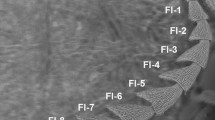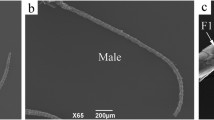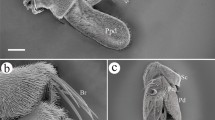Abstract
The sensilla of insects are integumental units that play a role as sensory structures and are crucial for the perception of stimuli and for communication. In this study, we compared the antennal sensilla of females (workers and queens), males (haploid (n) and diploid (2n)), and queen-like males (QLMs, resulting from 2n males after juvenile hormone (JH) treatment) in the stingless bee Melipona quadrifasciata. Images of the dorsal antenna surfaces were acquired using a scanning electron microscope. As reported for other hymenopterans, this species exhibits a heterogeneous sensillar distribution along the antennae. Thirteen different types of sensilla were found in the antennae of M. quadrifasciata: trichodea (subtypes I to VI), chaetica (subtypes I and II), placodea, basiconica, ampullacea, coeloconica, and coelocapitula. Sensilla trichodea I were the most abundant, followed by sensilla placodea, which might function in olfactory perception. Sensilla basiconica, sensilla chaetica I, sensilla coeloconica, and sensilla ampullacea were found exclusively in females. In terms of the composition and size of the sensilla, the antennae of QLMs most closely resemble those of the 2n male, although QLMs exhibit a queen phenotype. This study represents the first comparative analysis of the antennal sensilla of M. quadrifasciata. The differences found in the type and amount of sensilla between the castes and sexes are discussed based on the presumed sensillary functions.





Similar content being viewed by others
References
Abdalla FC, Jones GR, Morgan ED, Cruz-Landim C (2003) Comparative study of cuticular hydrocarbon composition of Melipona bicolor Lepeletier, 1836 (Hymenoptera, Meliponini) workers and queens. Genet Mol Res 2:191–199
Ahmed T, Zhang T, Wang Z, He K, Bai S (2013) Morphology and ultrastructure of antennal sensilla of Macrocentrus cingulum Brischke (Hymenoptera: Braconidae) and their probable functions. Micron 50:35–43
Al Ghamdi AA (2006) Scanning electron microscopic studies on antennal sensilla organs of adult honeybee workers in genus Apis (Hymenoptera: Apidae). Bull Entomol Soc Egypt 83:1–11
Antonini Y, Costa RG, Martins RP (2006) Floral preferences of a neotropical stingless bee, Melipona quadrifasciata Lepeletier (Apidae: Meliponina) in a urban forest fragment. Braz J Biol 66(2A):463–471
Asencot M, Lensky Y (1988) The effect of soluble sugars in stored royal jelly on the differentiation of the female honeybee (Apis mellifera L.) larvae to queens. Insect Biochem 18(2):127–133
Borges AA, Ferreira-Caliman MJ, Nascimento FS, Campos LAO, Tavares MG (2012) Characterization of cuticular hydrocarbons of diploid and haploid males, workers and queens of the stingless bee Melipona quadrifasciata. Insect Soc 59(4):479–486
Camargo CA (1977) Effects of juvenile hormone on diploid drones of Melipona quadrifasciata Lep. (Hymenoptera, Apidae). VIIIth International Congress I.U.S.S.I. Wageningen, Netherlands, pp 193–194
Chapman RF, Simpson SJ, Douglas AE (2012) The insects: structure and function, 5th edn. Cambridge University Press, Cambridge
Chen HH, Zhao YX, Kang L (2003) Antennal sensilla of grasshoppers (Orthoptera: Acrididae) in relation to food preferences and habits. J Biosci 28:743–752
Cruz-Landim C (2009) Abelhas: Morfologia e função de sistemas. Editora Unesp, São Paulo
Das P, Chen L, Sharma KR, Fadamiro HY (2011) Abundance of antennal chemosensilla in two parasitoid wasps with different degree of host specificity may explain sexual and species differences in their response to host-related volatiles. Microsc Res Tech 74(10):900–909
Esslen J, Kaissling KE (1976) ZAHL UND VERTEILUNG ANTENNALER SENSILLEN BEI DER HONIGBIENE (APIS MELLIFERA L.). Zoomorphology 83:227–251
Euzébio DE, Martins GF, Fernandes-Salomão TM (2013) Morphological and morphometric studies of the antennal sensilla from two populations of Atta robusta (Borgmeier 1939) (Hymenoptera: Formicidae). Braz J Biol 73(3):663–668
Faucheux MJ, Kristensen NP, Yenn SH (2006) The antennae of neopseustid moths: morphology and phylogenetic implications, with special reference to the sensilla (Insecta, Lepidoptera, Neopseustidae). Zool Anz 245:131–142
Ferreira RP (2011) Desenvolvimento do aparelho reprodutor de machos diplóides de Melipona quadrifasciata Lepeletier, 1836 sob a influência de hormônio juvenil. Dissertation, Federal University of Viçosa
Frasnelli E, Anfora G, Trona F, Tessarolo F, Vallortigara G (2010) Morpho-functional asymmetry of the olfactory receptors of the honeybee (Apis mellifera). Behav Brain Res 209:221–225
Freitas BM, Imperatriz-Fonseca VL, Medina LM, Kleinert AMP, Galetto L, Nates-Parra G, Quezada-Euán JJG (2009) Diversity, threats and conservation of native bees in the Neotropics. Apidologie 40:332–346
Galvani GL, González A, Roig-Alsina AH, Settembrini BP (2012) Distribution and morphometric studies of flagellar sensilla in Emphorini bees (Hymenoptera, Apoidea). Micron 43(5):673–687
Gillott C (2005) Entomology, 3rd edn. Springer, Netherlands
Gramacho KP, Gonçalves LS, Stort AC, Noronha AB (2003) Is the number of antennal plate organs (sensilla placodea) greater in hygienic than in non-hygienic Africanized honey bees? Genet Mol Res 2(3):309–316
Gupta M (1992) Scanning electron microscopic studies of antennal sensilla of adult worker Apis florae F (Hymenoptera: Apidae). Apidologie 23:47–58
Hartfelder K, Makert GR, Judice CC, Pereira GAG, Santana WC, Dallacqua R, Bitondi MMG (2006) Physiological and genetic mechanisms underlying caste development, reproduction and division of labor in stingless bees. Apidologie 37:144–163
Heard TA (1999) The role of stingless bees in crop pollination. Annu Rev Entomol 44:183–206
Inoue T, Roubik DW, Suka T (1999) Nestmate recognition in the stingless bee Melipona panamica (Apidae, Meliponini). Insect Soc 46:208–218
Johnson LK, Howard JJ (1987) Olfactory disc number in bee of different sizes and ways of life (Apidae: Meliponinae). J Kansas Entomol Soc 60(3):380–388
Kerr WE, Akahira Y, Camargo CA (1975) Sex determination in bees. Iv. Genetic control of juvenile hormone production in Melipona quadrifasciata (Apidae). Genetics 81:749–759
Kerr WE, Jungnickel H, Morgan ED (2004) Workers of stingless bee Melipona scutellaris are more similar to males than to queens in their cuticular compounds. Apidologie 35:611–618
Kleineidam C, Tautz J (1996) Perception of carbon dioxide and other “air-condition” P parameters in the leaf cutting ant Atta cephalotes. Naturwissenschaften 83:566–568
Kleineidam C, Romani R, Tautz J, Isidoro N (2000) Ultrastructure and physiology of the CO2 sensillum ampullaceum in the leaf-cutting ant Atta sexdens. Arthropod Str Dev 29:43–55
Klowden MJ (2007) Physiological systems in insects, 2nd edn. Academic Press, New York, p 699
Krebs CJ, Kenney AJ (2002) Fortran programs for ecological methodology. Exeter Software, East Setauket, New York 11733 (www.exetersoftware.com)
Kuwabara M, Takeda K (1956) On the hygroreceptor of the honey bee Apis mellifera. Physiol Ecol 7:1–6
Lambin M, Déglise P, Gauthier M (2005) Antennal movements as indicators of odor detection by worker honeybees. Apidologie 36:119–126
Marques-Silva S, Matiello-Guss CP, Delabie JHC, Mariano CSF, Zanuncio JC, Serrão JE (2006) Sensilla and secretory glands in the antennae of a primitive ant: Dinoponera lucida (Formicidae: Ponerinae). Microsc Res Tech 69:885–890
Meng ZJ, Yan SC, Yang CP, Ruan CC (2012) Asymmetrical distribution of antennal sensilla in the female Anastatus japonicus Ashmead (Hymenoptera: Eupelmidae). Microsc Res Tech 75(8):1066–1075
Moraes RLMS, Cruz-Landim C (1972) Estudo comparativo de órgãos sensoriais em abelhas com diferentes tipos de comunicação. Braz J Biol 32(2):185–196
Morisita M (1959) Measuring of the dispersion and analysis of distribution patterns dynamics. Memoires of the Faculty of Science, Kyushu University, Series E. Biology 2:215–235
Mustaparta H (1973) Olfactory sensilla on the antennae of the pine weevil, Hylobius abietis. Cell Tissue Res 144:559–571
Mysore K, Shyamala BV, Rodrigues V (2010) Morphological and development analysis of peripheral antennal chemosensory sensilla and central olfactory glomeruli in worker castes of Camponotus compressus (Fabricius, 1787). Arth Struc Dev 39:310–321
Nakanishi A, Nishino H, Watanabe H, Yokohari F, Nishikawa M (2009) Sex-specific antennal sensory system in the ant Camponotus japonicus: structure and distribution of sensilla on the flagellum. Cell Tissue Res 338:79–97
Nascimento MA, Fernandes-Salomão TM, Martins GF (2013) Estudos moleculares e morfológicos em abelhas do gênero Melipona (Hymenoptera). EntomoBrasilis 6(1):64–67
Nunes TM, Turatti IC, Mateus S, Nascimento FS, Lopes NP, Zucchi R (2009) Cuticular hydrocarbons in the stingless bee Schwarziana quadripunctata (Hymenoptera, Apidae, Meliponini): differences between colonies, castes and age. Genet Mol Res 8:589–595
Ochieng SA, Park KC, Zhu JW, Baker TC (2000) Functional morphology of antennal chemoreceptors of the parasitoid Microplitis croceipes (Hymenoptera Braconidae). Arth Struc Dev 29:231–240
Ozaki M, Wada-Katsumata A, Fujikawa K, Iwasaki M, Yokohari F, Satoji Y, Nisimura T, Yamaoka R (2005) Ant nestmate and non-nestmate discrimination by a chemosensory sensillum. Science 309:311–314
Rebora M, Piersanti S, Almaas TJ, Gaino E (2007) Hygroreceptors in the larva of Libellula depressa (Odonata: Libellulidae). J Insect Physiol 53:550–558
Renthal R, Velasquez D, Olmos D, Hampton J, Wergin WP (2003) Structure and distribution of antennal sensilla of the red imported fire ant. Micron 34:405–413
Saïd I, Tauban D, Renou M, Mori K, Rochat D (2003) Structure and function of the antennal sensilla of the palm weevil Rhynchophorus palmarum (Coleoptera, Curculionidae). J Insect Physiol 49:857–872
Shanbhag SR, Müller B, Steinbrecht RA (1999) Atlas of olfactory organs of Drosophila melanogaster 1. Types, external organization, innervation and distribution of olfactory sensilla. Int J Insect Morphol Embryol 28:377–397
Shang L, Wang Y, Wang P, Wang S, Ren B (2010) Application of rough set analysis in species and casts discrimination of bumblebees (Hymenoptera: Apidae: Bombus) based on antennal sensilla. Ann Entomol Soc Am 103(4):654–660
Spaethe J, Brockmann A, Halbig C, Tautz J (2007) Size determines antennal sensitivity and behavioral threshold to odors in bumblebee workers. Naturwissenschaften 94(9):733–739
Steinbrecht RA (1989) The fine structure of thermo-/hygrosensitive sensilla in the silkmoth Bombyx inori; receptor membrane substructure and sensory cell contacts. Cell Tissue Res 255:49–57
Stort AC (2002) Estruturas sensoriais de alguns representantes da família Apidae. An V Encontro sobre Abelhas, Ribeirão Preto – SP, Brasil. 151-155p
Stort AC, Barelli N (1981) Antennal sensory structures of Scaptotrigona postica (Hymenoptera: Apidae). J Kansas Entomol Soc 54(4):751–756
Stort AC, Moraes-Alves MMB (1999) Differences in the number of antennal sensory structures of males of three honey bee types. Rev Bras Biol 59:161–166
Van Baaren J, Boivin G, Lannic JL, Nénon JP (1999) Comparison of antennal sensilla of Anaphes victus and A. listronoti (Hymenoptera, Mymaridae), egg parasitoids of Curculionidae. Zoomorphology 119:1–8
Velthuis HHW, Koedam D, Imperatriz-Fonseca VL (2005) The males of Melipona and other stingless bees, and their mothers. Apidologie 36:169–185
Weidenmuller A, Kleineidam C, Tautz J (2002) Collective control of nest climate parameters in bumblebee colonies. Anim Behav 63:1065–1071
Wyatt GR (1992) Juvenile Hormone in insect reproduction a paradox? Eur J Entomol 94:323–333
Xi YQ (2011) Scanning electron microscopy studies of antennal sensilla of Ooencyrtus phongi (Hymenoptera: Encyrtidae). Microsc Res Tech 74:936–945
Yan SC, Meng ZJ, Peng L, Liu D (2010) Antennal sensilla of the pine weevil Pissodes nitidus Roel. (Coleoptera: Curculionidae). Microsc Res Tech 74(5):389–396
Yokohari F (1983) The colocapitular sensillum, an antennal hygro- and thermoreceptive sensillum of the honey bee, Apis mellifera L. Cell Tissue Res 233:355–365
Zacharuk RY (1985) Antenna and sensilla. In: Kerkut GA, Gilbert LY (eds) Comprehensive insect physiology, biochemistry and pharmacology, vol 6, Oxford: Pergamon., pp 1–69
Zakaria ME, Allam SF (2007) Effect of some aromatic oils and chemical acaricides on the mechanical defense behavior of honey bees against Varroa invasion and relationship with sensation responses. J Appl Sci Res 3:653–661
Zhou H, Wu WJ, Zhang FP, Fu YG (2013) Scanning electron microscopy studies of the antennal sensilla of Metaphycus parasaissetiae Zhang & Huang (Hymenoptera: Encyrtidae). Neotrop Entomol 42(3):278–287
Acknowledgments
We acknowledge the Núcleo de Microscopia e Microanálises, Universidade Federal de Viçosa, Minas Gerais, for technical assistance. Financial support was provided by Coordenação de Aperfeiçoamento de Pessoal de Nível Superior (CAPES).
Author information
Authors and Affiliations
Corresponding author
Additional information
Communicated by: Sven Thatje
Electronic supplementary material
Below is the link to the electronic supplementary material.
Supplementary Fig
SEM image showing the surface of an antenna of a queen of M. quadrifasciata. The red square represents a selected area (230 × 230 pixels) for sensilla counting in a flagellum (F). (GIF 343 kb)
Rights and permissions
About this article
Cite this article
Ravaiano, S.V., Ferreira, R.d.P., Campos, L.A.d.O. et al. The antennal sensilla of Melipona quadrifasciata (Hymenoptera: Apidae: Meliponini): a study of different sexes and castes. Naturwissenschaften 101, 603–611 (2014). https://doi.org/10.1007/s00114-014-1184-0
Received:
Revised:
Accepted:
Published:
Issue Date:
DOI: https://doi.org/10.1007/s00114-014-1184-0




